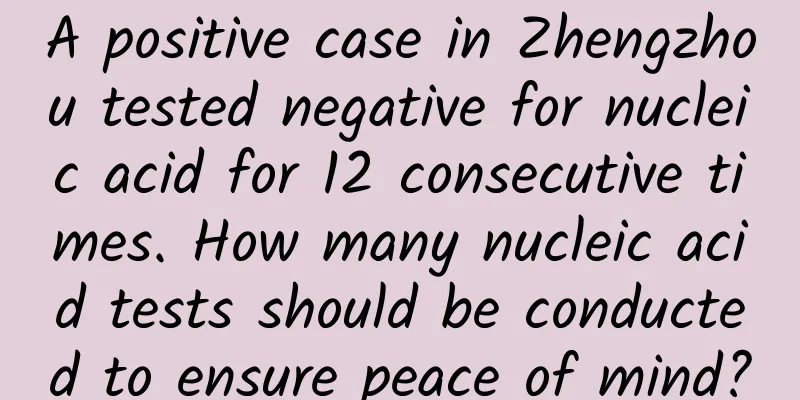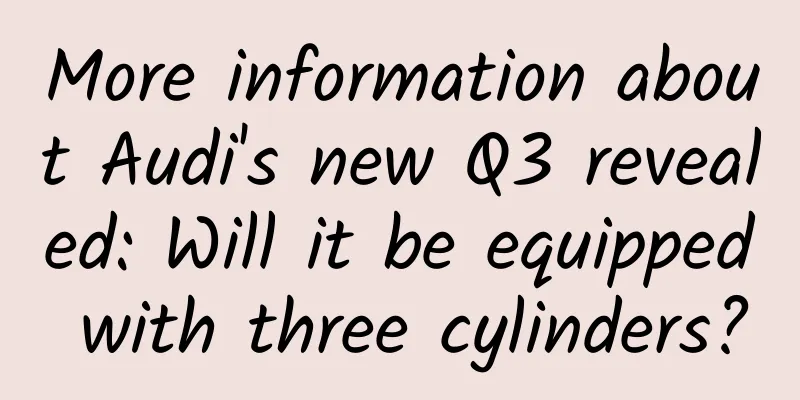A positive case in Zhengzhou tested negative for nucleic acid for 12 consecutive times. How many nucleic acid tests should be conducted to ensure peace of mind?

|
Recently, a positive case in Zhengzhou tested negative for nucleic acid for 12 consecutive times and was discovered after being isolated for 9 days. Why do nucleic acid tests sometimes "slip through the net"? How many times do we need to test to be assured? Interview experts: Zhang Yongxiang (Chief Physician of the Respiratory Department of Beijing Daxing District People's Hospital) At 20:00 on November 16, a press conference on the prevention and control of the new coronavirus pneumonia epidemic in Zhengzhou, Henan Province reported that a total of 53 confirmed cases have been reported in this round of epidemic. Among them, case No. 53, newly added on November 14, was discovered after 9 days of centralized isolation. Prior to this, 12 consecutive nucleic acid tests had been conducted since November 3, and the results were all negative. This case also proves once again that a small number of infected people have a long incubation period, and epidemic prevention and control cannot be sloppy. Why do nucleic acid tests have "slips"? How many times do we need to be tested to be assured? How to determine positive nucleic acid test? It took 12 nucleic acid tests to show a positive result. Could it be that the technology that can make the new coronavirus "appear" has really failed? Of course not! Wang Guiqiang, chairman of the Chinese Medical Association's Infectious Diseases Branch and director of the Department of Infectious Diseases at Peking University First Hospital, said in an interview with the media that nucleic acid testing itself is stable, and the so-called failure to detect or false negatives and false positives are mainly because any detection method has a sensitivity problem. Since there are differences in the principle and practice of nucleic acid testing for the new coronavirus, there is a possibility of "inaccuracy". Zhang Yongxiang, chief physician of the respiratory department of Beijing Daxing District People's Hospital, told reporters that the new coronavirus, like the SARS coronavirus, is composed of RNA (ribonucleic acid), protein, etc., and the outermost layer is composed of lipids and glycoproteins. RNA is easily degraded (destruction of certain individual RNA fragments and chains in the cell), and the protein capsid will wrap the RNA in it and protect the RNA together with the envelope coat. The new coronavirus will invade cells through receptors on the surface of specific cells to cause infection, and use the cells of the infected person to replicate and proliferate. ▲Photo of the new coronavirus under a microscope (picture from the Internet) Therefore, medical workers can collect cell samples from specific parts of the human body and test whether they contain viral RNA to confirm whether the body is infected. The nucleic acid of RNA is composed of 4 different bases. If the four bases are arranged in pairs, there are 8 forms. The bases of the 4 connected sites have 256 ways of arrangement. The more bases that make up RNA, the more complex the arrangement combination. The new coronavirus has tens of thousands of bases. The nucleic acid of the virus is like our ID card, which is its unique identity. Nucleic acid testing is to identify the "identity" of the new coronavirus. Taking the commonly used PT-PCR technology as an example, if someone has contracted COVID-19 and needs to be examined, medical staff will collect cells with the virus from him and transport them to the laboratory, fully inactivate them, destroy their original structure, expose nucleic acids, and then use the probe in the reagent to see if it can highly match certain key parts of RNA. Each successful match will generate a corresponding fluorescent signal, indicating that the "gene ID card" has been identified, and the PCR detector will record the fluorescent signal value in real time. After repeated checks, the fluorescence intensity is getting higher and higher, and an upward curve will appear on the detection software, indicating that the test is positive, proving that the sample contains the RNA of the new coronavirus. What causes "uncertainty"? Zhang Yongxiang said that virus nucleic acid testing is one of the necessary conditions for confirming a positive diagnosis. From a technical perspective, nucleic acid testing is a multi-step process, including sampling, transportation, inactivation, nucleic acid extraction, PCR reaction, etc. Any wrong operation or problems with reagents or equipment in any link may lead to "false negative" or "false positive" samples. In the actual operation of nucleic acid testing, if there are quality problems with the nucleic acid testing kit or sampling tube, it will lead to fundamental inaccurate measurement; in addition, if the amount of virus preservation solution extracted is too small and the volume of nucleic acid elution solution added to the PCR system for testing is too low, there will be a risk of nucleic acid loss, causing the results to deviate from the true value. The current COVID-19 nucleic acid test requires a throat swab or a nasopharyngeal swab. The correct throat swab collection requires wiping both pharyngeal tonsils and the posterior pharyngeal wall at the same time. The nasopharyngeal swab collection should be gently inserted into the nasal passage, stay at the nasal palate for a while, and then slowly rotate and withdraw. However, the collection of samples from these two places was rarely carried out in clinical practice in the past, so the sampling personnel basically started centralized training and operation in 2020. Inadequate personnel training is bound to cause inconsistent operations, which may also lead to inconsistent nucleic acid test results for the same person each time. ▲Testers identify collected samples in the laboratory (Photo/Visual China) Studies have shown that the respiratory specimen with the highest detection rate is bronchoalveolar lavage fluid, followed by lung tissue, aspirated sputum or nasopharyngeal aspirate, and then nasopharyngeal swab or throat swab. Therefore, although nasopharyngeal swab or throat swab testing is convenient and fast, it is not the most accurate method. If the patient's infection has reached the middle and late stages of the disease, the virus is concentrated in the lower respiratory tract, and the nasopharynx is no longer the main infection area. Nasopharyngeal swabs or throat swabs may be "inaccurate" after repeated testing. Zhang Yongxiang said: "Different people may have different viral loads. If the viral load is particularly high, it will take a shorter time to detect. If the viral load is very low, it may be more difficult to detect the result." In fact, it is not difficult to imagine that for the same batch of samples tested, their gene sequences are amplified at the same multiple ratio during the amplification phase of the test. For samples carrying more viral gene sequences, there will be more viral genes after the amplification is completed. When tested with a test kit, they may be closer to the minimum detection limit of the test kit and easier to detect. For samples with low viral content, although they are also amplified at the same multiple ratio, when tested with a test kit, the amplified viral genes are far less than those of samples carrying more viral gene sequences. In other words, only through multiple viral nucleic acid tests can we catch the "slippery fish" carrying viral nucleic acids. A patient had five consecutive nucleic acid tests, only one of which was positive, and the rest were negative. The doctor checked the patient's medical history and found that the patient was a human immunodeficiency virus (HIV) carrier who had been taking anti-HIV drugs for a long time. The load of the new coronavirus in his body may be lower than the detection limit due to the effect of the drugs, resulting in repeated negative nucleic acid tests. In addition, when laboratory testers operate, cross-contamination between specimens or laboratory contamination may occur, which may also lead to inaccurate results. For a standardized clinical laboratory, there are strict quality control strategies, which can generally effectively avoid false positive results of viral nucleic acid detection. In addition, factors such as changes in the condition, the speed of progression of the patient's condition, the timing and time interval of sampling will also affect the test results. How many times do you need to do nucleic acid tests to be “safe”? When the reporter interviewed experts, he learned that due to the many factors that affect nucleic acid testing, 1 to 2 or even 3 consecutive negative nucleic acid results cannot guarantee that the person being tested does not carry the new coronavirus. But for non-close contacts, the nucleic acid test results are more like a "pass" - ensuring that they can participate in certain group gathering activities, so generally testing is done on demand, and at the same time, they should also pay attention to protection. So for the general public, repeated testing is not necessary. Repeated testing is required for key subjects, such as close contacts. At the beginning, the amount of virus excreted may not be much, and the throat swab may not be detected, but it does not mean that there is no virus in the body. Therefore, we need to conduct multiple tests. A single negative nucleic acid test is actually not safe for key subjects. (Picture from the Internet) For suspected cases or close contacts, multiple tests may be required if the risk of illness has not been eliminated. According to the seventh edition of the new coronavirus diagnosis and treatment plan, screening such as routine blood tests and ground-glass lesions on lung CT scans is also required, and tests such as new coronavirus-specific antibodies (IgG and IgM) may also be performed. In addition, due to individual differences, tolerance and previous medical conditions among different people will have a certain impact on sampling. Therefore, the number of times the virus nucleic acid test needs to be done should be determined based on many comprehensive influencing factors. References: 1. Zhang Rui, Li Jinming. How to reduce false negatives in novel coronavirus nucleic acid testing[J]. Chinese Medical Journal, 2020, 100(011): 801-804. 2. Wang Qian, Wang Jianzhong. Clinical Laboratory Medicine[M]. Beijing: People's Medical Publishing House, 2015. 3. Li Jin, Ye Guangming, Chen Liangjun, et al. Analysis of causes and countermeasures of false negative results in novel coronavirus nucleic acid testing[J]. Chinese Journal of Laboratory Medicine, 2020, 43(03): 221-225. 4. Wang Da, Dong Liang, Qing Song, et al. Misconceptions in novel coronavirus nucleic acid testing[J]. Chinese Journal of Hospital Infection, 2020, 30(08):1167-1170. 5. Notice on Issuing the Diagnosis and Treatment Plan for Novel Coronavirus Pneumonia (Trial Version 8) http://www.nhc.gov.cn/xcs/zhengcwj/202008/0a7bdf12bd4b46e5bd28ca7f9a7f5e5a.shtml 6. Notice of COVID-19 Nucleic Acid Testing at Peking Union Medical College Hospital https://www.pumch.cn/detail/23552.html Written by reporters Song Meng, Lai Tianying, and Feng Xiaohong (Medical and Health Group) Graphic editor/Chen Yongjie New media editor/Lv Bingxin Produced by: Science Central Kitchen Produced by: Beijing Science and Technology News | Science Plus Client Welcome to share to your circle of friends Reproduction without authorization is prohibited |
<<: How did people in the Ming and Qing dynasties do charity? ——Study Room No. 1
>>: The USS Ford may be deployed in 2022, but the parts of the USS Kennedy must be dismantled first
Recommend
These major scientific and technological achievements were praised in the government work report.
On March 13, the two sessions of the National Peo...
Presbyopia suddenly disappears, white hair suddenly turns black...6 diseases that suddenly "get better" are more dangerous!
In life, if a disease that has troubled you for a...
WeChat is fighting with Alipay, who is the king of B-side?
[[273439]] Recently, there was a piece of news th...
WeChat has 6 major advertising types, and all of them support mini-program delivery!
From now on, all advertisements in the WeChat eco...
China Association of Automobile Manufacturers: Production and sales of automobile industry in October 2024
According to the analysis of the China Associatio...
Using technology to experience "X-ray vision"? Mothers no longer have to worry about not finding blood vessels when inserting needles?
What is the difference between humans and jellyfi...
Dismantling Spark Education’s K12 Education Operation Growth Strategy
Today's case comes from Chen Xi, an outstandi...
“Shaping 2021”, how much do you know about these scientific news selected by Nature?
On the 14th local time, the news editor of the we...
Analysis of Zhihu content operation and promotion strategy!
While the number of registered users of Zhihu has...
The logical method of traffic promotion!
Obtaining traffic will always be an eternal and c...
Alibaba's autonomous driving route begins to take shape: Wang Gang leads the team, L4 takes the lead
The rumors began to be verified more and more. Th...
Having trouble breathing and dry cough, but can’t find the cause? Learn more about this disease!
Author: Fang Baomin, Chief Physician, Beijing Hos...
I squeezed a pimple and almost sent myself to the ICU! @Everyone: Fight against acne with your wits
Many people have experienced "battle acne&qu...
All-round home entertainment center Laura Unicorn home entertainment host first review
Previously, we brought you the first preview of t...
How to study at the beginning of the school year? Follow the aerospace scientists!
The new semester has begun. Are you ready to meet...









